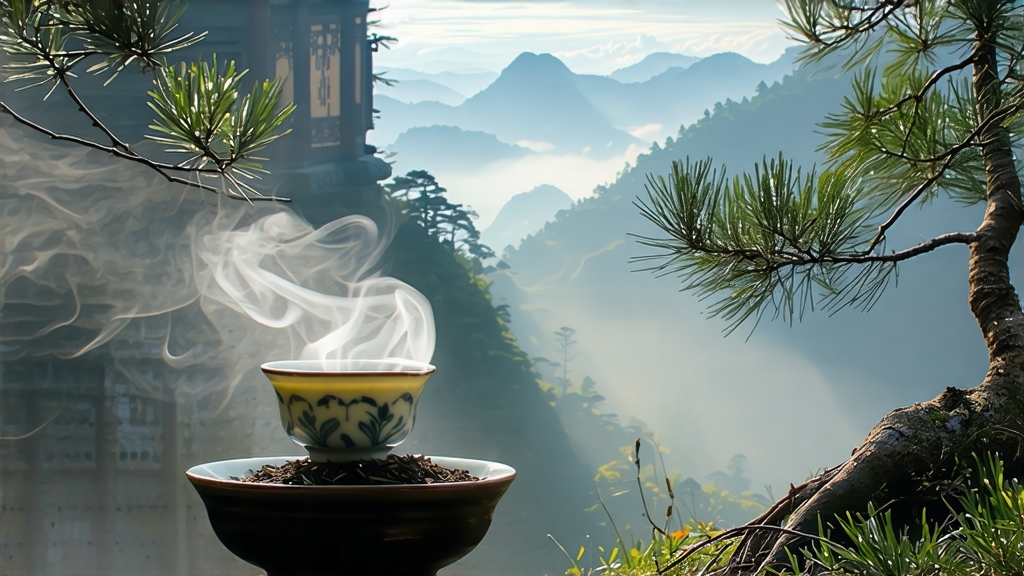
Long before English merchants coined the term “black tea,” the mountain villages of Tongmu in China’s Wuyi range were finishing their spring leaves over glowing pine embers. The result—Lapsang Souchong—became the first fully oxidized tea ever documented, the prototype for every future black tea, and a flavor so arresting that European royalty once paid its weight in silver. Today, while mass-market copies rely on artificial smoke, the authentic leaf remains a tiny, seasonal craft guarded by fewer than two hundred families. Understanding its story is to taste the hinge on which global tea history turns.
Historical roots
Local legend places the birth of Lapsang Souchong during the late Ming dynasty, around 1604, when passing soldiers commandeered a tea workshop mid-process. To dry the leaves quickly, workers spread them over fresh pinewood fires. The smoky aroma delighted the Dutch traders who first carried the cargo to Europe, where it was christened “Bohea” after the Fujianese port of Xiamen. By the early Qing, court records list “Xiaozhong” (small-sort) tribute teas arriving in Beijing, and by 1660 Pepys was writing of “a cup of tee, a China drink,” almost certainly Lapsang, served in London coffee-houses. The tea’s success spurred the search for faster production methods, indirectly leading to the Assam and Ceylon industries. Thus, every modern breakfast blend owes a debt to these pine-scented leaves.
Terroir and cultivar
Authentic Lapsang Souchong can only be produced inside the 650-meter core zone of Tongmu Guan, a narrow gorge carved by the Chongyang stream. Here, subtropical mists rise from the valley floor each morning, shading the tea gardens in a natural shade-cloth that slows photosynthesis and concentrates amino acids. The soil is a loose, acidic laterite rich in quartz and manganese, prized for drainage yet able to retain just enough moisture. Growers rely on the indigenous Xiao Ye Zhong (“small-leaf species”), a slow-growing shrub whose narrow leaves contain more geraniol and linalool than standard Camellia sinensis var. sinensis, precursors that translate into peach and honey notes once smoked.
Two styles: smoked versus unsmoked
International buyers often assume “Lapsang” automatically means smoky, yet within Tongmu the locals distinguish between Zheng Shan Xiao Zhong (unsmoked “original mountain small-sort”) and the traditional pine-smoke version. The unsmoked style, increasingly popular in China, is withered, rolled, fully oxidized, and then charcoal-baked over a gentle bamboo-wood fire; it yields a russet liquor with dried-longan sweetness and a cooling alpine finish. The classic smoked version, still preferred in the West, receives its final drying above a pinewood hearth, absorbing resinous volatiles that bond with the leaf’s natural sugars to create notes of cured bacon, single-malt whisky, and winter campfire.
Crafting the smoke
Production begins in the first week of May, when two leaves and a bud are plucked at dawn. After an eight-hour outdoor wither under mountain breeze, the leaves are moved into a three-story wooden loft called a qinglou. On the ground floor, fresh pinus taiwanensis logs are lit; the fire is immediately smothered with damp sawdust, generating a cool, aromatic smoke that drifts upward through bamboo trays. Over the next twelve hours, artisans shuffle the trays every twenty minutes, ensuring even absorption. Oxidation follows in cloth-lined wicker baskets, where the leaves redden at 26 °C and 75 % humidity. Finally, the tea is flash-baked for ninety seconds above the same pine embers, locking in fragrance while reducing moisture to 3 %. The entire process is timed to the village’s only mechanical clock: the church-like clang of the tea master’s shovel against cast iron.
Grading the leaf
Within Tongmu, quality is judged by the size of the original leaf. “Pinhead” grades, composed of the tiniest early buds, deliver a refined, almost citrusy smoke. “Cannon” grades, made from the fourth or fifth leaf, carry a heavier, tarry edge prized by Russian samovar drinkers. Between these extremes lie “Pekeo” and “Souchong,” names later appropriated by Indian planters. The best lots, fewer than 300 kg per season, are hand-sorted on winter nights when static electricity is lowest, allowing workers to detect and remove any stem that